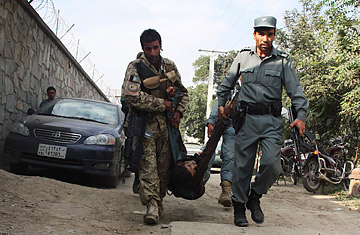
Afghan security officials carry the body of a fallen comrade after armed Taliban militants launched attacks in Kabul on Sept. 13, 2011
Four earth-shaking explosions in Kabul on Tuesday signaled the start of the Taliban's latest riposte to claims by the top U.S. military commander in Afghanistan that the insurgents are on the run. After a Sunday truck bombing that had injured 77 American troops, militants stormed a high-rise close to the U.S. embassy and began firing rocket-propelled grenades and machine guns. In hellish scenes replayed repeatedly on Afghan TV, dust swirled on deserted streets as civilians, some soaked in their own blood, fled whenever a letup in the fighting allowed. Under a gunmetal sky, Afghan military Mi-24 Hind helicopter gunships flew in to support a rapid-reaction force, unleashing bursts of heavy machine-gun fire back at insurgent positions. "This is not an exercise," the public-address system at nearby NATO headquarters crackled. "This is an ongoing situation."
From the half-built high-rise, muzzle flashes flared in the gloom and militants launched rocket-propelled grenades at the fortress-like U.S. embassy. One overshot, chewing up tarmac on the main drag that leads into the heart of Kabul's diplomatic enclave. The building, originally intended as a shopping mall, offered such good lines of fire over NATO headquarters, the U.S. embassy and, farther away, the presidential palace, that a police checkpoint had been established to prevent entry to the higher levels. But enough of the skeletal structure had been erected to give the insurgents their firing platform. "They're on the fourth floor," Afghan police Lieut. Colonel Haji Mohammad told TIME close to the scene of the fighting. "We're not sure if they're all dead yet."
The answer came soon enough in a rumble of heavy machine-gun fire, and then long sustained bursts from U.S. troops guarding a base across the road from the U.S. embassy. Jumpy police and Afghan soldiers had locked down the long road leading to the siege site, allowing only fleeing civilians and wounded security personnel through. Tensions flared as the battle continued. A police pickup carrying an officer with a gunshot wound to the neck screeched to a halt besides an Afghan army checkpoint, demanding entrance to the military hospital behind. "Only if you disarm," came the reply, at which point a police officer drew his pistol and angrily fired two rounds into the air before snarling off in search of another medical facility.
Insurgents had also struck in other parts of Kabul, where they targeted police and intelligence installations. One suicide bomber wounded four people while another was shot and killed by police before he could detonate, and a third blew himself up near a high school. The multipronged raid is one the most sophisticated to date by the Taliban, which claimed responsibility. The BBC reported that calls made on phones retrieved from the bodies of the attackers had been traced to Pakistan, and later U.S. Ambassador Ryan Crocker confirmed the attacks had been orchestrated by the Pakistan-based Haqqani network, an autonomous group fighting under the Taliban umbrella. Raids by multiple, heavily armed suicide bombers are a modus operandi of the group.
Three Afghan civilians and an Afghan guard outside the U.S. embassy had been wounded, including a girl waiting for a visa who "suffered a chest wound," according to a source at NATO headquarters; she was taken by helicopter to Bagram air base for treatment. In Washington, Secretary of State Hillary Clinton said the U.S. mission in Kabul "will not be intimidated by this kind of cowardly attack." By midmorning Wednesday, with the fighting finally over, the number of casualties stood at 27 dead, including Afghanistan police, civilians and insurgents. According to the AP, U.S. Marine Corps Gen. John Allen said that of those killed, 11 were Afghan civilians, with over half children and five Afghan police officers killed. He said that 11 insurgents died in the battle.
Around 9 p.m. local time — almost eight hours after the attacks began — NATO special forces and an Afghan counterterrorism unit began clearing the high-rise where the remaining militants had holed up. "The first, second, third and fourth floors have been cleared by international forces and an Afghan counterterrorism unit," an official with the National Directorate of Security told TIME. "The suicide bombers — we don't know exactly how many are left — they've gone upstairs." But the battle for the building continued all night, with the NATO and Afghan teams closing the net slowly amid heavy fighting for possession of each floor. Afghan officials confirmed that the last of the militants had been killed around 9 a.m. Wednesday.
The protracted siege was an embarrassment for NATO and its Afghan partners. Privately, diplomatic officials in Kabul have heaped scorn on NATO chief Anders Fogh Rasmussen's statement in Brussels yesterday that "the enemies of Afghanistan ... have not succeeded and they will not succeed. They will not derail transition." But that's not the view in the Afghan capital. "Rome burns and transition's on track," remarked one diplomatic official sarcastically. "That's the amazing thing; what will it take before anyone admits that things may need a rethink?" Rasmussen's Panglossian view is shared by others, including U.S. Ambassador Ryan Crocker, who was quoted in the Washington Post claiming progress on the security front, and saying that "the biggest problem in Kabul is traffic." But Taliban attacks continue and grow more sophisticated, clouding NATO hopes of making a dignified exit from a war that shows no sign of ending after almost 10 years.
